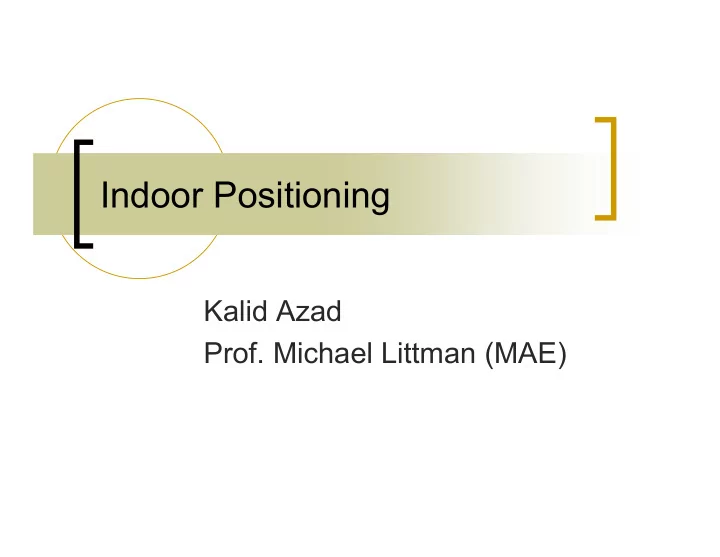

Indoor Positioning Kalid Azad Prof. Michael Littman (MAE)
Problem Description � Determine position accurately indoors � Cool because: Unsolved problem! � Indoor robots, interactive maps, security � � Hard because: GPS doesn’t work indoors � Alternatives: Radio, ultrasonic, IR � Need cheap alternative (GPS atomic clocks ~ $100k) � Resolution: Better than room level … 1 foot possible? �
A Change of Heart � After some research, decided: � Can use phase differences in sine waves � Receiver can solve for position 1 wavelength = Possible location
Things Look Ugly � Unfortunately… � Requires custom hardware � Which requires a custom OS � And custom software � And custom (i.e. no) debugging tools � A MIT Master’s Thesis was on a similar subject � Unfortunately, couldn’t get everything working
Revelation � Use existing hardware/software Learned about Microsoft research using wireless � networks (thanks to Michael Newman) Can get a cheap wireless card & free software � Main idea: measure signal strengths at various � locations Create a table � Later, someone visits an unknown location � They record their current signal strength � Find closest match in table �
Bumps along the way � Smaller problems � Needed access to device drivers to get signal strengths � Luckily, found some utilities � Netstumbler, Lucent’s tools Log signal strengths to a file � � Now a matter of text extraction and manipulation � Time to learn Perl! Built in hash tables �
Bigger, Better, Faster � Getting signals isn’t enough � Need quality signals � Emphasize positioning, not just data transfer � Solution: an antenna � Found various “homebrew” antennas on the Web � Pringles can, soup can… � Work comparably to $100 commercial ones, cost < $10
A Little Theory � EM propagation hard, but main idea: � Antenna based on wavelength � 2.4 GHz (802.11b) roughly 12cm � Manageable size If RF (MHz), could have been tens or hundreds of � meters for a “perfect” antenna (i.e., a radio tower) � Sine wave peaks at ¼ wavelength (3 cm) � Set up a standing wave and tap it at 3 cm. � Still don’t understand all the details, but have books and learning more =)
How do they do? � Pringles vs. soup? � Both directional antennas � “Amplify” signal in some directions, decrease it in others � Non-powered components, so can’t boost signal
Signal-to-noise ratio (1 second intervals) No antenna - 1 second intervals Pringles - 1 second intervals Can - 1 second intervals Pringles Can No antenna 50 50 50 45 45 45 40 40 40 35 35 35 30 30 30 25 25 25 20 20 20 15 15 15 10 10 10 5 5 5 0 SNR(2) 0 SNR(2) 0 SNR(3) Seconds Seconds Seconds The colors are the strengths to 3 access points
Shaky - what if we average? � Good idea – but... � How long will you stay in one place? � More than 10-20 seconds unreasonable � Enough time to get a decent sample? � Does the signal vary too much, even for averaging? � Let’s see…
20 second moving avg. No ant enna - 1 second int ervals Pringles - 1 second int ervals Can - 1 second intervals No antenna Pringles Can 60 60 60 50 50 50 40 40 40 30 30 30 20 20 20 10 10 10 0 0 0 1 76 151 226 301 376 451 526 601 676 751 826 901 976 1051 1126 1201 1276 1351 1426 1501 1576 1651 1726 1801 2 5 7 4 5 1 26 51 76 101 126 151 176 201 226 251 276 301 326 351 376 401 426 451 476 501 526 551 576 601 626 651 676 701 726 751 Seconds Seconds Seconds Bad Ugly Good
Signal-to-Noise ratio SNR comparison - diameter is std. dev 50 40 none Min SNR 30 pringles 20 can 10 0 38.00 40.00 42.00 44.00 46.00 Average SNR
Results � Soup is the winner! Usually has low range (max-min), highest avg. � Also, smaller size � Theory: soup is a waveguide, vs. the Pringles Yagi � antenna – want to learn why soup wins Pringles enhances signal… � …but still shaky over 20 seconds of averaging � Sometimes beat the can with std. deviation, but also � had larger swings (max – min) No antenna � Size (or lack thereof) is the sole advantage � Also a disadvantage – need roughly 6-12cm for an � good antenna at 2.4 GHz
My method � Go to a location, log strength for ~30 seconds.
Extract and average data to create a profile for the location Average Values Acces point name
Log signals, and look it up…
A Long Journey… � But learned a lot along the way Perl for text extraction � EM theory & 802.11b � Some MySQL to manage database � How to quickly devour a can of Pringles to make � an antenna Lessons: � Cool things can be made from simple components, � many of which already exist Don’t build everything from scratch � You can find anything on the Internet! (drivers, utilities, � theory explanations, design specs, hardware)
Conclusions � Only recently got it working, but… Using the can, can distinguish to about 10 feet � confidently CS building has a lot of access points � Can resolve to about ~1 meter in the best case � Original goal achieved: better than room-level � Cheap, efficient, relatively simple, uses existing � hardware Need more tests to determine exact resolutions � Will most likely be a % error at that resolution � New metrics for comparison � Weighted avg: weight more for low std. dev. �
Recommend
More recommend